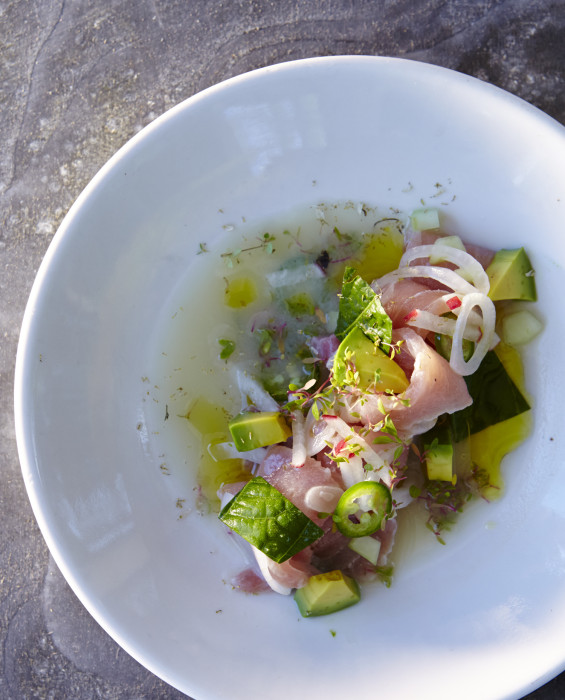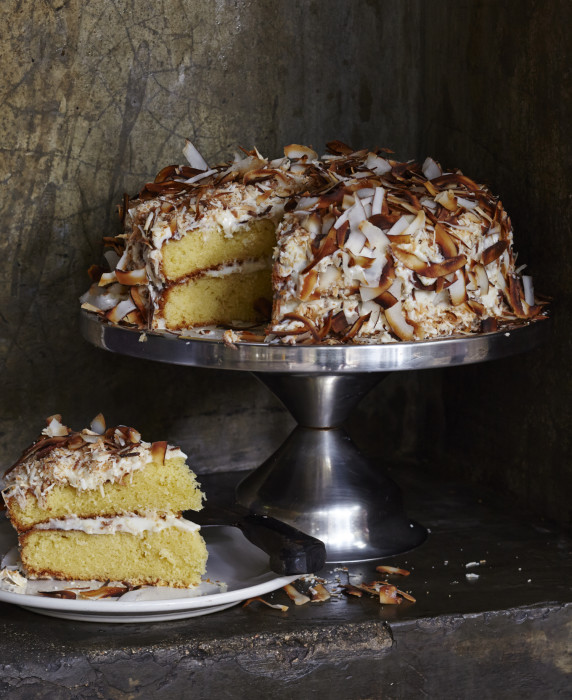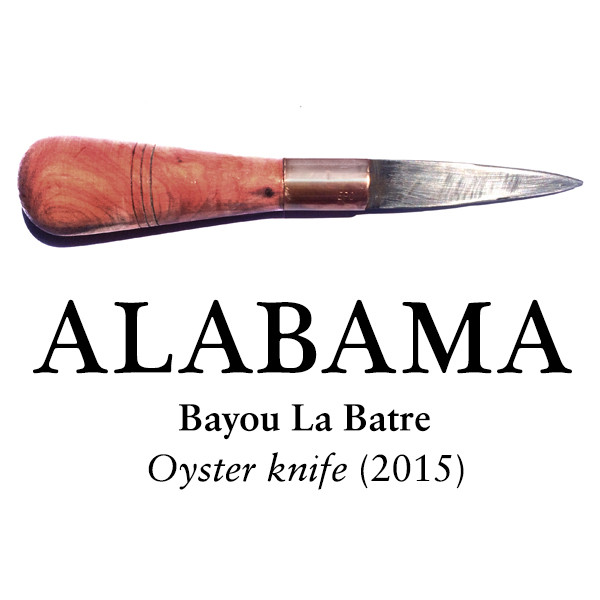
“Excerpted from Hartwood by Eric Werner and Mya Henry (Artisan Books). Copyright © 2015. Photographs by Gentl & Hyers.”
“Hartwood is the place I dream about.” So quips acclaimed Noma chef Rene Redzepi in the foreword of the divine cookbook celebrating not just the restaurant that onetime New Yorkers Eric Werner and Mya Henry escaped to Tulum to open five years ago, but also the vibrant traditions and lush landscape of their new home in the Yucatan Peninsula. I’ve had the immense pleasure of experiencing Hartwood firsthand so I can second Redzepi’s sentiment that it is in fact the stuff of dreams. And their first cookbook is equally dreamy. Chapters are divided in a manner that reflects the place: El Almacen (the larder), El Mercado (the market), El Mar (the sea), La Tierra (the land), then Los Dulces (desserts) and Las Bebidas (drinks). Each one unfolds with detailed dossiers about ingredients (how to supreme citrus, advice for seasoning your cast iron, a primer on masa and tortillas), tales of this magical place on the edge of the Yucatan (a glimpse at the cenote pools, serene jungle walks), and, of course, recipes perfectly evocative of this singularly beautiful tropical environment (like agave pork belly with grilled pineapple or pulpo tostadas or chilled avocado soup with epazote). Yes, some of the ingredients called for will be hard to locate for many of us urban and suburban dwellers, but in most cases substitute ideas are offered. Local (to the Yucatan) fish like jurel and robalo can be swapped with your preferred white, firm-fleshed variety and if you can’t find avocado leaves, you can try toasted ground fennel seeds instead. While the recipes and stories set the scene, Hartwood’s exquisite images captured by the brilliant Gentl & Hyers (regular Gather contributors) really give the book a uniquely transporting quality. So as the winter chill sets in follow this plan: prepare one of the recipes excerpted below, eat while gazing at the Hartwood pictures, then start scanning Kayak for cheap flights. FV

“Excerpted from Hartwood by Eric Werner and Mya Henry (Artisan Books). Copyright © 2015. Photographs by Gentl & Hyers.”
Ceviche de Aguja with Ginger and Mezcal
Serves 4 to 6
The earthy, smoky flavor of the mezcal sets up both the sharpness of the citrus in the marinade and the fattiness of the avocado. When shopping for marlin, look for a lean fillet with no fatty layers between the muscle—that fat is too chewy for a ceviche. If you can’t find lean marlin, ask for lean swordfish. If the only marlin (or swordfish) at the fish market is fatty, then don’t make ceviche: those cuts are best roasted in the oven.
Ginger Mezcal Agua
½ cup thinly sliced ginger
½ cup fresh lime juice (from 5 to 6 limes)
1 cucumber, peeled and cut into chunks
2 tablespoons mezcal
½ teaspoon honey
1 serrano chile, coarsely chopped
⅓ cup dried chamomile or organic chamomile tea
Kosher salt
Ceviche
1 pound marlin fillets, cut into ¼-inch-thick slices (see Note)
½ teaspoon kosher salt
⅓ cup Pickled White Onions (recipe follows)
4 radishes, julienned
1 serrano chile, thinly sliced
⅓ cup ½-inch cubes seeded cucumber
¼ cup hoja santa leaves, cut into ½-inch squares (optional)
1 Hass avocado, halved, pitted, peeled, and cubed
½ teaspoon dried chamomile or organic chamomile tea for garnish
Radish sprouts for garnish (optional)
Sea salt for garnish
1. Make the ginger mezcal agua: Combine the ginger, lime juice, cucumber, mezcal, honey, serrano, and chamomile in a blender and blend on high for about 30 seconds, until well blended. Pass through a fine-mesh strainer into a bowl and add salt to taste.
2. Put the marlin in a bowl, add the ginger mezcal agua and salt, and gently mix to combine. Add the pickled white onions, radishes, serrano, cucumber, and hoja santa, if using, and mix gently. Let stand for 1 to 2 minutes.
3. Using a slotted spoon, divide the ceviche among individual serving bowls. Spoon about 2 tablespoons of the ginger mezcal agua over each serving. Garnish with the avocado, chamomile, radish sprouts, if using, and sea salt.
Pickled White Onions
1 white onion, thinly sliced on a mandoline or with a sharp knife
1 cup white vinegar
1 tablespoon sugar
1½ teaspoons kosher salt
We make most of our pickles with a simple cold brine solution because we’re not preserving these ingredients so much as focusing their flavors. Most of the following pickles are best refrigerated for at least 4 hours before using, or overnight, in order to allow the flavors to develop, but you can use them sooner if you must. They will keep in the refrigerator for a week.
Almost all the pickles below work the same way: slice up what you’re going to pickle and put it into a jar, mix the brine solution, and pour it in. These recipes are designed to work for a 1-pint Mason jar, but the yield from the produce you use might be different from what we get in the Yucatán. If you have too much solution, don’t use it all; if you have too little, give the jar a shake every so often to distribute the liquid. Don’t limit yourself to the following recipes—once you get the hang of it, start pickling all your favorite produce.
Note:
How to Slice for Ceviche
When you cut fish for ceviche, angle your knife at 45 degrees and make thin cuts against the grain so that each piece is about ¼-inch thick. Make sure that you are slicing in one fluid movement—it’s like slicing through an apple, not sawing though a loaf of bread. Be mindful that the grain might change as you move along the fish, so be sure to adjust the angle of your cut accordingly. Take your time. You’re making ceviche for you and your friends, not trying to beat the clock.
At Hartwood, we slice tuna loin into lengths and sprinkle with salt and chamomile for a quick cure before cutting into thin slices for ceviche.

“Excerpted from Hartwood by Eric Werner and Mya Henry (Artisan Books). Copyright © 2015. Photographs by Gentl & Hyers.”
Toasted-Coconut Cake
Serves 8-10
The coconut palms growing on the beach in Tulum are miraculous trees. Even though they’re battered by the salty air and exposed to the harsh sun, they still produce fruit filled with a slightly sweet water that’s as refreshing as it is healthy and a sweet milky flesh you can eat raw.
At Hartwood, we use fresh coconuts for this cake, but that’s a hard recipe to put down on paper. The coconuts here are harvested every day—you’re simply not going to find the same quality in a store. So instead we call for cream of coconut, which is a perfectly legitimate substitution. Just be sure to stir the contents of the can before measuring it out.
Cake
½ cup coconut oil
3 cups all-purpose flour
1 teaspoon baking soda
¾ teaspoon kosher salt
2 cups sugar
8 tablespoons (1 stick) unsalted
butter, softened
3 large eggs
2 large egg yolks
1 cup well-stirred sweetened cream of coconut (such as Coco López)
¾ cup plain whole-milk yogurt
2 teaspoons vanilla extract
Frosting
Two 8-ounce packages cream
cheese, softened
½ cup confectioners’ sugar
¼ cup water, or as needed
1 tablespoon dark rum
½ teaspoon fresh lime juice
½ teaspoon vanilla extract
Pinch of salt
1 cup unsweetened coconut flakes, and 1 cup shredded coconut, toasted until golden brown
1. Preheat the oven to 325°F. Liberally grease two 9-inch springform pans with 2 tablespoons each of the coconut oil; set aside.
2. Sift the flour, baking soda, and salt into a medium bowl; set aside.
Using a handheld electric mixer, cream the sugar, butter, and the remaining ¼ cup coconut oil in a large bowl until well blended, about 3 minutes (it will look like wet sand). Add the eggs and yolks one at a time, beating well after each addition, then beat for an additional 2 minutes. Beat in the cream of coconut, yogurt, and vanilla. Add the flour mixture, mixing on low just to blend.
3. Pour the batter into the prepared pans. Gently shake the pans from side to side to smooth the tops. Bake for about 1 hour, or until the top of the cake is golden and a toothpick or tester inserted into the center comes out clean. Remove from the oven and let cool in the pans on a wire rack for 30 minutes.
4. Run a thin knife around the sides of the pans and remove the pan sides. Let the cake cool completely before frosting.
5. Make the frosting: Using a handheld electric mixer, beat the cream cheese and confectioners’ sugar on medium-low speed until light and creamy, about 3 minutes. Beat in the water, rum, lime juice, vanilla, and salt until blended; add more water, 1 teaspoon at a time, if the frosting is too thick.
6. Put one cake layer on a serving plate and frost the top. Put the second layer on top and frost the top and sides of the cake. Sprinkle some toasted coconut flakes on top and gently press the rest into the sides.
Warning: opendir(/nas/content/live/gatherjournal/wp-includes/images/media): failed to open dir: No such file or directory in /nas/content/live/gatherjournal/wp-includes/post.php on line 7113
Notice: Undefined variable: icon in /nas/content/live/gatherjournal/wp-includes/post.php on line 7183
Advertisement

